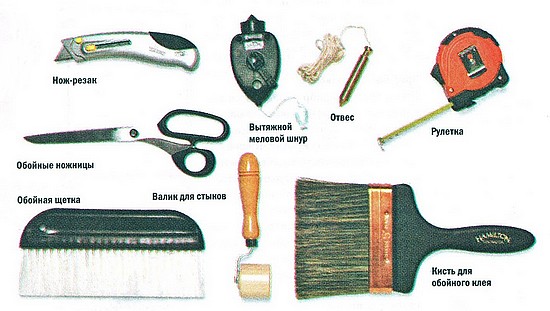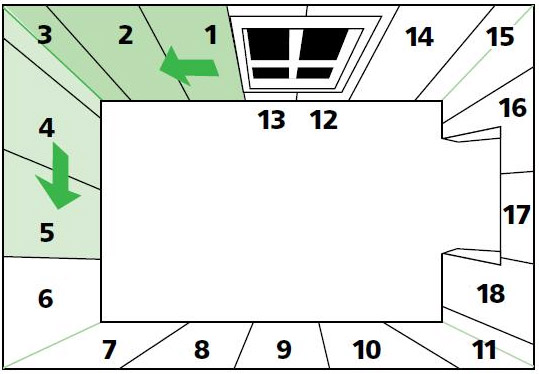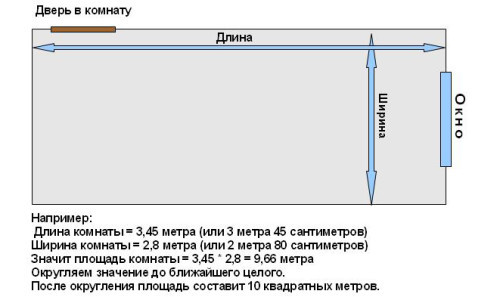If you decide to carry out repairs yourself, you need toprovide appropriate training both theoretical and practical. It is important to familiarize yourself with the principles of wallpaper gluing, find out where to start gluing wallpaper, how to choose the right texture, shades. After all, in order to achieve the most qualitative result, it is necessary with all responsibility to approach the organization of decorative finishing and interior planning of the room.  A scheme for wallpapering your own hands.
A scheme for wallpapering your own hands.
What do you need to know for beginners?
Many years ago, in Soviet times, wallpaper gluedjust lapped. The main secret of this method was the presence of a specialized, non-specular strip on one side of the material. On this strip and glued the next layer. The gluing was carried out only from the window. This was done so that no transitions with a strip were noticeable. But most often they were noticeable, although not so much as if you were sticking from another point. Now you can start to glue the wallpaper from any place. However, most people follow the tradition, starting from the window. It is known that the main task during decorative wall decoration with wallpaper is clear lines and beauty, so it is worth starting with a line that specifies a strict vertical. In the role of such a vertical can act:
- doors;
- window;
- angles.
In addition, you can simply draw a line that will be perpendicular to the floor. To do this, use the level.  Tools for gluing wallpaper. Before you start to glue wallpaper, you need to prepare the necessary tools:
Tools for gluing wallpaper. Before you start to glue wallpaper, you need to prepare the necessary tools:
- ruler, tape measure, calculator and pencil for marking and measuring;
- roller, scraper and spatula to remove wallpaper;
- a shear knife, scissors and a cutter for cutting strips;
- clean floor or large table, brush and bucket for surface treatment with glue;
- plummet, stepladder, hammer, spirit level and nails for leveling and gluing;
- sponge and cleaning cloth.
It is important to properly prepare the room. First of all, you must disconnect the sockets, and then remove the covers. It is necessary to glue the wallpaper over the holes for the sockets. Slots are made after the glue dries. It is recommended to approach the doors on both sides. In this case, the canvas applied on the door must be cut to the height of the frame vertically. Then it is fastened to the wall, cutting off the ledge, which is adjusted to the top of the frame. To make it easier to trim the lower and upper edges, it is worth using a triangular ruler. Back to contents</a>
The order of wallpaper gluing
The first cloth must be glued tightly toand then step by step forward until the circle (more precisely, the rectangle) closes. In this case, it is necessary to take into account the angle of the sun's rays from the window, otherwise the joints will be very prominent, spoiling the impression. Sometimes the door jamb becomes the starting point. It is believed that the apartments are most often changed by interior doors, so their angles become the most even. Doors have an ideal vertical level (during the repair it is the level of doors that are most often checked and leveled), so there is no need to measure the jamb level.  The order of wallpaper gluing. The idea of starting to glue wallpaper from such an ideal vertical line is that, starting with it, you can continue the cycle of gluing. It turns out, that each strip transfers a full vertical, therefore it is necessary to glue walls in a circle. It is known that now it is difficult to find an ideally flat corner in the apartment. The fault of this is Soviet construction, so it is necessary to check the angles with the help of a building level. It is worthwhile to measure the correlation of angles before deciding whether it is worth using such a corner as a reference point. A more important question is where to start gluing the wallpaper in the corner. You can not stick a single canvas in the corner, because it can become unstuck or creases appear on it. It is recommended to paste several adjacent sheets overlap. This will take more time, but the result will be more reliable and qualitative. If the wallpaper has a geometric or other large pattern, then it is likely that in the case of gluing in a closed circle, at the start and finish points (the first and last strip, the drawings will not converge at all.) And the reason for this is not the pictures themselves, but the wallpaper position. time, the vertical is lost, and the wallpaper begins to dodge with every successive wall.</a>
The order of wallpaper gluing. The idea of starting to glue wallpaper from such an ideal vertical line is that, starting with it, you can continue the cycle of gluing. It turns out, that each strip transfers a full vertical, therefore it is necessary to glue walls in a circle. It is known that now it is difficult to find an ideally flat corner in the apartment. The fault of this is Soviet construction, so it is necessary to check the angles with the help of a building level. It is worthwhile to measure the correlation of angles before deciding whether it is worth using such a corner as a reference point. A more important question is where to start gluing the wallpaper in the corner. You can not stick a single canvas in the corner, because it can become unstuck or creases appear on it. It is recommended to paste several adjacent sheets overlap. This will take more time, but the result will be more reliable and qualitative. If the wallpaper has a geometric or other large pattern, then it is likely that in the case of gluing in a closed circle, at the start and finish points (the first and last strip, the drawings will not converge at all.) And the reason for this is not the pictures themselves, but the wallpaper position. time, the vertical is lost, and the wallpaper begins to dodge with every successive wall.</a>
What should I consider while choosing wallpaper?
Before you glue wallpaper, you need to know about all of themfeatures. The determining factor during the selection is the condition of the walls and the purpose of the premises. For rooms with normal humidity and even walls, almost any finishing materials are suitable. While for rooms with high humidity or vestibules washable wallpaper is best.  Scheme of calculating the area of the room for gluing wallpaper. Flizelinovye perfectly hide minor irregularities, do not give a strong shrinkage, and they are very easy to work with, because the glue must be applied simply on the wall. But it's worth paying special attention to the corners, because you need to properly glue the wallpaper in these places to avoid the formation of folds. Relief materials also help to hide minor wall irregularities. Good for this purpose fit wallpaper with large cells, dense pattern or glass fabric. Everyone who wants to decorate their interior in a folk or oriental style, as well as lovers of environmentally friendly and expensive materials should pay attention to natural wallpaper. Most often these are bamboo products that perfectly fit into different interiors and are considered the best assistant for the Japanese style. There are still liquid wallpaper. This is a very original coating, suitable for any premises. It is applied as a simple plaster on the substrate, and then the layer should become soft, like a fabric. Acrylic wallpaper is like a vinyl cover. They differ only in the layer deposited on the paper. You can glue this type of wallpaper in a variety of rooms, because they are not afraid of moisture and mechanical impact. They differ from the vinyl thickness, which is a few millimeters smaller. This should be taken into account if different materials are combined in the interior. It is important to remember that the mold appears precisely in the corners: although many start to glue the wallpaper from there, first of all, it is necessary to process the corners with fungicides. Back to contents</a>
Scheme of calculating the area of the room for gluing wallpaper. Flizelinovye perfectly hide minor irregularities, do not give a strong shrinkage, and they are very easy to work with, because the glue must be applied simply on the wall. But it's worth paying special attention to the corners, because you need to properly glue the wallpaper in these places to avoid the formation of folds. Relief materials also help to hide minor wall irregularities. Good for this purpose fit wallpaper with large cells, dense pattern or glass fabric. Everyone who wants to decorate their interior in a folk or oriental style, as well as lovers of environmentally friendly and expensive materials should pay attention to natural wallpaper. Most often these are bamboo products that perfectly fit into different interiors and are considered the best assistant for the Japanese style. There are still liquid wallpaper. This is a very original coating, suitable for any premises. It is applied as a simple plaster on the substrate, and then the layer should become soft, like a fabric. Acrylic wallpaper is like a vinyl cover. They differ only in the layer deposited on the paper. You can glue this type of wallpaper in a variety of rooms, because they are not afraid of moisture and mechanical impact. They differ from the vinyl thickness, which is a few millimeters smaller. This should be taken into account if different materials are combined in the interior. It is important to remember that the mold appears precisely in the corners: although many start to glue the wallpaper from there, first of all, it is necessary to process the corners with fungicides. Back to contents</a>
Practical tips for combining different materials
When combining different materialsConsider the basic methods of combining them, taking into account the texture, shades and many other points. With the help of combining you can develop design skills, ensuring the original design of the interior. The question arises: how to glue the wallpaper, using the horizontal alternation of several different materials? It is recommended to glue the upper part first and then the lower part. Thus, the canvases will be glued overlapping, and there will be a little material left between them, which will diminish upon drying. It remains to trim the excess parts, pasting the joint with a special decorative material, for example:
- decorative molding;
- curb;
- wooden panel.
This will help hide the joint. Some people with vertical alignment begin to glue the wallpaper from the window, moving into the interior of the room. The first band turns out to be indicative. This arrangement provides an opportunity to hide joints, because they will get less light. In the case of interlacing, first of all, we need to glue the background wallpaper, using the traditional technique of gluing the walls. As soon as the first layer dries, you can glue the embossed decorative inserts. They can be located anywhere, because the joints hide with the help of wooden slats. Main in this process are accuracy and patience. The work done hastily, most often have to be remade.


